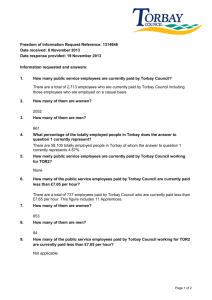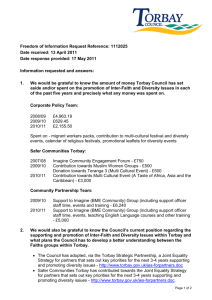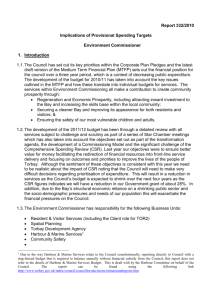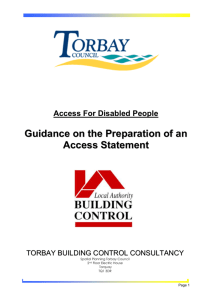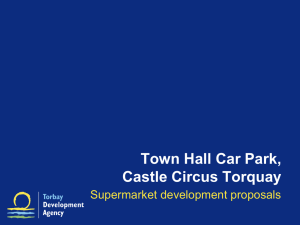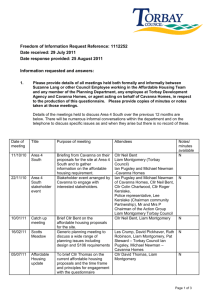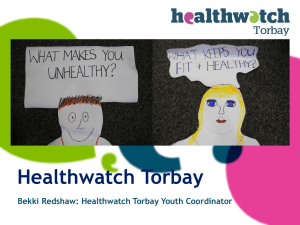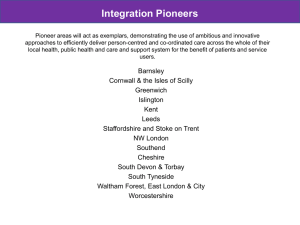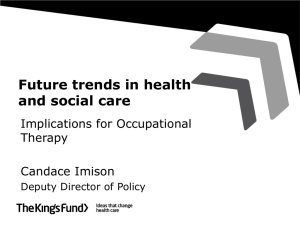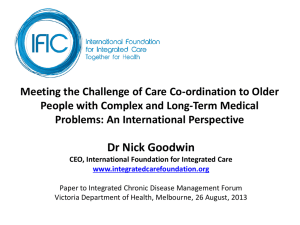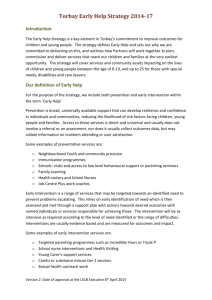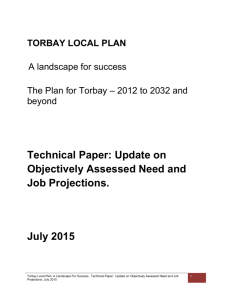POPULATION ASSUMPTIONS
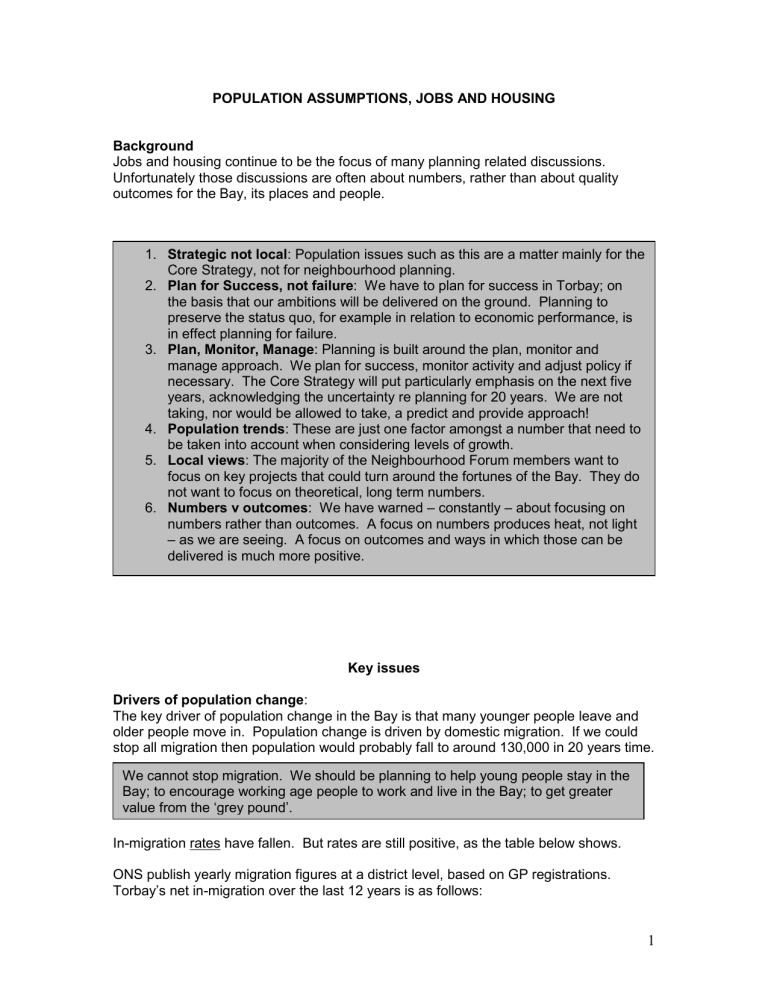
POPULATION ASSUMPTIONS, JOBS AND HOUSING
Background
Jobs and housing continue to be the focus of many planning related discussions.
Unfortunately those discussions are often about numbers, rather than about quality outcomes for the Bay, its places and people.
1. Strategic not local : Population issues such as this are a matter mainly for the
Core Strategy, not for neighbourhood planning.
2. Plan for Success, not failure : We have to plan for success in Torbay; on the basis that our ambitions will be delivered on the ground. Planning to preserve the status quo, for example in relation to economic performance, is in effect planning for failure.
3. Plan, Monitor, Manage : Planning is built around the plan, monitor and manage approach. We plan for success, monitor activity and adjust policy if necessary. The Core Strategy will put particularly emphasis on the next five years, acknowledging the uncertainty re planning for 20 years. We are not taking, nor would be allowed to take, a predict and provide approach!
4. Population trends : These are just one factor amongst a number that need to be taken into account when considering levels of growth.
5. Local views : The majority of the Neighbourhood Forum members want to focus on key projects that could turn around the fortunes of the Bay. They do not want to focus on theoretical, long term numbers.
6. Numbers v outcomes : We have warned – constantly – about focusing on numbers rather than outcomes. A focus on numbers produces heat, not light
– as we are seeing. A focus on outcomes and ways in which those can be delivered is much more positive.
Key issues
Drivers of population change :
The key driver of population change in the Bay is that many younger people leave and older people move in. Population change is driven by domestic migration. If we could stop all migration then population would probably fall to around 130,000 in 20 years time.
We cannot stop migration. We should be planning to help young people stay in the
Bay; to encourage working age people to work and live in the Bay; to get greater
In-migration rates have fallen. But rates are still positive, as the table below shows.
ONS publish yearly migration figures at a district level, based on GP registrations.
Torbay’s net in-migration over the last 12 years is as follows:
1
Year 98/99 99/00 00/01 01/02 02/03 03/04 04/05 05/06 06/07 07/08 08/09 09/10
Net inmigration
1200 2300 2100 1500 1700 1800 700 700 900 500 600 400
Source: ONS/NHS Central Register.
Figures for 2011 will come out in June. These figures must be treated with caution as they do not capture people who do not register with a GP. Torbay probably has a higher than average proportion of non-GP registered population. A much clearer picture on population and migration will become available when the Census data is made available, hopefully later this year, but this is not a reason to delay plan making.
We must plan for success, in other words that the housing market and economy will recover. We must be realistically ambitious for the Bay. The plan, monitor, manage approach will ensure we don’t ‘over-provide’ on the basis of long term predictions.
Population projections
These have fallen significantly since the 2004 projections, but are still projected to rise.
Again, the 2011 Census data will shed more light on this but is not reason in itself to delay sensible plan making.
ONS Sub-National Population projections for Torbay (000s)
2012 2016 2021 2026 2031
2008 based (2010) 136.8
2006 based (2008) 140.1
2004 based (2006) 143.7
Source ONS
140.2
145.2
149.3
145.1
152.1
156.2
150.2
158.9
165.5
155.2
165.2
-
The population of Torbay is still predicted to rise, but at a slower rate than previously.
These projections are trend based, so it ’s likely the credit crunch has reduced the projected rate of population increase. As part of the plan, monitor, manage approach, we will keep population increases under review and amend our approach accordingly.
Household size
Household size is falling, towards an average of 2 people per household from around 2.4 people per household 10 years ago. This is as a result of people living longer, increased divorce rates. On the basis of the current population of the Bay (i.e. assuming no migration in or out), 9,300 houses would be needed over the next 20 years simply to
‘consume it’s own smoke’.
The most recent household projections (2010), show an increase of 13,000 households in Torbay between 2011-2031.
2
It is this figure (13,000 households) on which our five year housing land supply is judged.
Recent public inquiries, regarding Wall Park and Scotts Meadow, have hinged on this figure. Torbay was found (see wall Park decision) not to have a five year supply of land against this most up to date, robust figure. Nationally, is it the same measure that is being used to determine the outcome of appeals. It will be the measure against which the Core Strategy and Neighbourhood Plans will be tested by inspectors / independent examiners.
The National Planning Policy Framework, to be published on 27 March 2012, will require
Councils to provide a 6 year supply of deliverable housing land (i.e. +20%).
The Council has, for the last 10 years or so, said Torbay can accommodate around
10,000 jobs and 10,000 houses
. This is based on very robust assessment of Torbay’s capacity in terms of environment and infrastructure. The 10,000 homes figure is defensible, we feel, but a lower figure is likely to lead to the Core Strategy (and
Neighbourhood Plans, being found unsound. If the decision on Scotts Meadow aligns with the Wall Park decision, in terms of the 13,000 households baseline figure, we may have to revisit the 10,0 00 ‘target’. We cannot afford to ignore two warning shots.
Housing and Jobs
Torbay has a successful R&D sector. Economic trends suggest that, over the next 3 -5 years, we’ll see growth in tourism, hotel and catering; some growth in manufacturing, an increase in professional and financial services. Our priorities for inward investment include advanced electronics, medical and healthcare; business process outsourcing.
There are already a very high number of micro and nano business in Torbay, with around 4,000 of these being operated from home. This reveals a niche opportunity for the Bay – as a place for high end design, research and development businesses – because it provides a fantastic location for ‘lifestyle’ businesses. We need the infrastructure, such as innovation space, competitive property and wage costs, to support start up, small and growing businesses.
The Regional Observatory has forecast Torbay will have the 4th fastest growing economy in the South West over the next 3 – 5 years, with employment growing to
48,900 by 2016 at 1.9% per annum, equating to around 800 jobs per annum. Beyond
2016, jobs growth is expected to continue at around 450 jobs per annum. We have already seen earnings growing by around 13% in the last two years, indicating these growth forecasts could come true......if we get the right conditions for growth in Torbay
(premises, infrastructure, skills....).
It’s important we bring forward opportunities for high quality jobs in parallel with housing, if it’s not possible to bring them not ahead of housing.
At White Rock around 1000 new jobs are being created, by ensuring that housing is enabling early provision of employment space. At Yannons Farm, a new Pharmaceutical
Manufacturing Unit, providing around 230 jobs, is to be built as part of a mixed use scheme. These mixed use schemes are coming forward on sites that history and businesses tell us are no longer needed for pure employment purposes. Mixed use development of such sites, which are in less environmentally sensitive parts of the Bay, provide a ‘win win’ solution to employment and housing – sustainable, balanced growth.
3
Jobs in housing
Laying the Foundations: A Housing Strategy for England (DCLG Nov 2011), says
“Getting house building moving again is crucial for economic growth – housing has a direct impact on economic output, averaging 3 per cent of GDP in the last decade every new home built, up to two new jobs are created for a year 2 .
1 .
For
Without building new homes our economic recovery will take longer than it needs to.”
Research by the international management consultancy L.E.K.2 calculates that every £1 spent on construction output generates a total of £2.84 in total economic activity 3 .
We should not underestimate the importance of jobs in housing. This will be construction jobs in the short term, whilst houses are built, and then ‘maintenance’ jobs (plumbing, electricity etc) during the lifetime of a house. It’s important that we ensure local people benefit from house building and construction generally, through training schemes etc.
Mechanisms to secure this are already in place.
1
Office for National Statistics (ONS) Construction Output. See: www.ons.gov.uk/ons/publications/ re-referencetables.html?edition=tcm%3A77-224276
2 DCLG analysis (based on Scottish Government estimates of construction employment multipliers and previous English
3
Partnerships guidance). See: www. scotland.gov.uk/Topics/Statistics/Browse/Economy/ Input-Output/Mulitipliers
L.E.K (2009) Construction in the UK Economy
– The Benefits of Investment.
4

